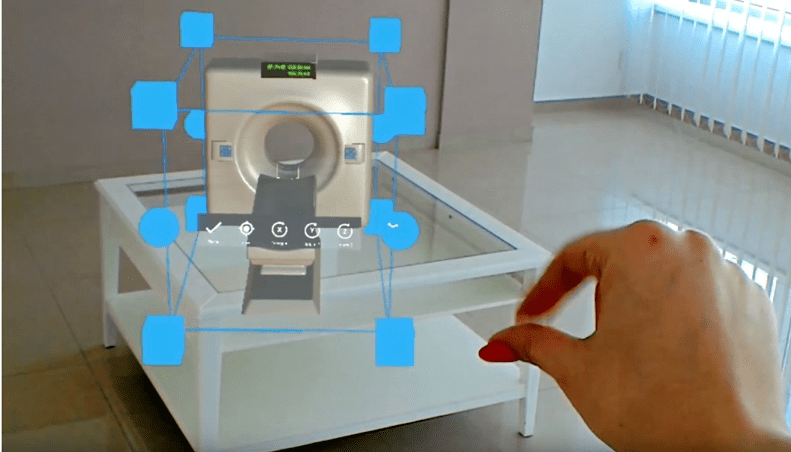Consumer needs and aspirations are driving today’s marketplaces more and more. These preferences shift as technology develops, and a company needs to adapt to stay relevant. A new development in marketing and sales tactics is augmented reality (AR), which enables companies to provide their clients with distinctive experiences through the ease of using their mobile devices.
One of the most important media platforms for customers to engage with companies and make decisions about what to buy is mobile. Augmented Reality (AR) adds another weapon to your arsenal for boosting sales and elevating brand value via mobile devices.
What is Augmented Reality?
Before we get deep into the specifics of augmented reality and marketing, it would help to talk about augmented reality in general. Augmented reality is a form of technology that superimposes digital components into the real world.
What does this mean?
With AR, you can use a screen to enhance the world around you. One of the most famous and early augmented reality examples was a mobile application called Pokémon GO. This app lets users view the real world on their phone screen using the device’s camera. The twist is that they can also see and interact with Pokémon (make-believe creatures from the media franchise of the exact name) through the same lens. Ultimately, this enables players to “catch” Pokémon anywhere in the globe.
While that’s a specific example, AR always uses this same concept. Whether you utilize a phone screen, smart glass, or another type of viewer, AR combines virtual assets with real-world displays.
As an exciting technological concept, how do you mix AR with marketing?
1. Let customers try before they buy
Potential customers have always wanted to try products before purchasing them. Fitting rooms, cosmetic samples, automobile test drives, and many other related concepts testify to the effectiveness of this sales strategy. Augmented shopping experiences are one of the rising trends in the retail industry.
Using AR, prospective customers can model and try on makeup, clothing items, and a wide range of home-related products without needing to directly interact with them. AR negates the need for a large physical inventory to allow customers to try on or sample dozens or even hundreds of items in search of the one that best meets their needs.
The applications of augmented reality in this sphere have already begun to multiply as more businesses realize the benefits AR presents. As might be imagined, Facebook has been keen to pioneer AR applications. Its augmented reality offering allows users to digitally sample makeup and accessories, allowing them to model how they look with them before buying anything. The first Facebook AR-related advertisement let potential customers try on virtual sunglasses with the aid of their device’s camera.
The cosmetics industry has also been enthusiastic about embracing augmented reality in recent times. Brands like Sephora, L’Oreal, and Perfect Corp have created partnerships to allow their customers to see how the makeup would look on them digitally. Augmented reality is particularly valuable for online sales strategies involving cosmetics, as consumers almost always need to judge a given makeup item by modeling it on themselves.
Another area where AR has the potential to shine is in creating a virtual fitting room or dressing room. When it comes to purchasing clothing, dressing rooms are a necessary evil. Customers are required to lug stacks of clothing items to the dressing room and then employees are constantly needed to restore discarded items. In addition to this, a store is limited by the inventory on hand when it comes to offering clothing for customers to try on.
The augmented reality changing room dispenses with much of that hassle, allowing customers to tap into a digital library of clothing items at the tap of a finger. Brands like Topshop and Timberland have been at the forefront of developing AR fitting and changing rooms to give their customers a virtual experience in helping them select clothing items.
2. Augment touring and assistance
Augmented reality offers the potential for businesses to add a digital component on top of their physical locations and products. Customers can scan a product or object to pull up an AR experience tailored either toward giving additional information about the product or some form of supplemental brand-related experience.
The application of AR in this regard stretches into numerous industries and markets. For example, the ticket sales company StubHub created an augmented reality app, which allowed users to view a 3D display of the stadium where the Super Bowl was played. Fans were able to visualize the look of the field from various seats to choose the right seat for them.
Starbucks has turned to augmented reality to digitize the experience of touring one of its coffee shops. Users can scan objects within the shop to access a virtual tour, conveying additional information to supplement the physical site.
Within the auto industry, Hyundai and Mercedes have both been adopting AR applications. Hyundai was the first to create an augmented manual for drivers and Mercedes has taken this concept a step further. Mercedes owners can access a feature called ‘Ask Mercedes’, which pairs an AI assistant with an augmented reality interface to answer a host of potential questions.
3. Augment branding materials
Augmented reality can take branding materials like business cards and brochures to the next level by adding a virtual component. Users can scan printed materials with their mobile devices to access a range of features giving them more information and ways to get in contact with the brand.
For instance, a user can scan a brochure in the right spot to bring up a video highlighting some aspect of the information being conveyed, bringing a dynamic element to the static text on the brochure. Alternatively, a business card can use AR to present a variety of contact options that will allow the user to get in touch with a single click, whether through email, LinkedIn, or by phone call.
AR-enhanced branding materials let their creators inject dynamic virtual elements into the text, heightening engagement.
4. Create a buzz around the brand
Augmented reality can also be used as part of an indirect sales and marketing strategy. While the previous AR applications focused on direct tactics for facilitating sales, AR can also be used to enhance the status of the brand itself.
Creating a novel, unexpected or fun augmented reality experience can result in a significant buzz for a brand if executed properly. AR is a relatively new phenomenon for most people, meaning that a well-designed AR experience will get people talking and generate lasting memories. As people prefer a brand that keeps them happy and satisfied, that kind of exposure and customer goodwill can pay lasting dividends.
Read Also: Evaluating the Impact of Chatbots Through Analytics
A perfect example of using augmented reality to create buzz would be a Pepsi campaign situated at a bus station. Pepsi allowed users to access an AR virtual window alongside the bus station’s wall. Users were treated to the sight of a marauding tiger, UFOs, and robots running loose within the AR vista. By leavening the tedium of waiting for a bus with an augmented reality experience, Pepsi managed to generate discussion and strengthen its brand.
Uber has since followed suit with a similar campaign in Zurich, creating AR experiences for their riders and generating more than one million YouTube views.
By employing strategies like this, companies can generate millions of dollars in earned media. In a competitive market, an augmented reality campaign can be that differentiator that allows a brand to stand out from its peers and create sustained discussion and name recognition.
5. Leverage augmented reality for B2B
Augmented reality stands ready to transform the B2B customer/vendor experience in several ways. The B2B sales process has always been fraught with the tug-of-war between customer expectations and the limitations of what a vendor is realistically able to provide. AR has the potential to create significant improvements along the entire chain of the sales process.
One of the most significant areas in which AR can improve B2B sales is in creating dynamic sales presentation material. The old model used to arm salespeople with brochures and flyers, and perhaps a PowerPoint presentation. Contrast that with a salesforce equipped with a digital device allowing them to access customized augmented reality applications presenting a virtual 360-degree look at their product lines. It is easy to see which sales team has the upper hand.
AR sales tools can allow customers to see and interact with products in as detailed a way as they desire, from a high-level overview to a granular inspection of individual components. By bringing the product into the meeting room, augmented reality allows customers greater access to the information they need to make a decision.

AR is also a massive boon when it comes to dealing with customization options. As a general rule, customers are looking for as much customization and specifically tailored products and solutions as they can get. Managing those demands from the vendor side isn’t always easy.
Augmented reality tools can facilitate customers taking an active part in the design of their products. This input can then be digitally conveyed in real-time to the vendor, providing a smoother chain of feedback leading to customers getting exactly what they want, and vendors being able to provide it for them. AR can create a bridge between customer expectations and vendor fulfillment.
AR offers a similarly outsized impact when it comes to post-sales support. Too often, customers find themselves relying on user manuals or online knowledge repositories, which don’t help all that much or are difficult to navigate. This can lead to frustration that results in a customer taking their business elsewhere.
Augmented reality solutions in the customer support arena are only now starting to come to fruition, but the early returns are extremely promising. From AR manuals to the possibility of remote tech support via AR, augmented reality offers the possibility of making customer service more interactive and responsive.
Why Use Augmented Reality For Sales and Marketing?
Augmented reality personalizes sales and marketing experiences by helping customers understand how a product works, its features, etc., and how it would fit into their real world. For example, Wayfair created a View in Room” feature within its app that takes advantage of Tango, an augmented reality technology from Google that allows shoppers to see how the furniture they are thinking of buying would fit into their homes. Shoppers use their smartphones to view 3D sofa images and choose to save them to their idea board or browse and buy.
The Lowe’s Vision app has a feature called In-Store Navigation which also uses Tango. The home improvement company added the feature so customers can interact with their store designs via their mobile devices and add products to their shopping list. They may follow directional prompts they receive through their screens superimposed on the real world. Lowe’s Vision was designed to offer customers virtual guides in some of its stores using the most efficient routes.
Ikea, the multinational furniture conglomerate, has also embraced augmented reality. The Swedish company’s RA works in much the same way as Wayfair, allowing customers to see before buying what the furniture available in their homes would look like. The experience is similar to how people try on clothes in a store before buying them.
Sephora, the French multinational beauty brand, has pioneered AR through software that offers shoppers a more personalized experience without seeking the help of an outlet clerk. With AR, the Sephora app overlays makeup styles and shades of makeup products on the wearer’s face. The test screen has a button at the bottom that guides shoppers through the store’s checkout process.
The following are seven ways that augmented reality is boosting sales and customer experiences.
Improving decision making by eliminating indecisiveness
One of the reasons consumers have been reluctant to buy some things online was the inability to interact with the product and test it to make sure it is what they are looking for. Doubt introduces indecision. Augmented reality creates renewed confidence in online shopping and will increase the value of the e-commerce market as retail moves constantly to the internet.
Adding value to customers’ shopping experiences
In a post-pandemic world, the world will rely more on contactless transactions. AR will be at the center of this shift, flipping how retail and e-commerce work: from making an all-inclusive over-the-web shopping experience to creating new levels of customer satisfaction.
Adding value to interactive packaging
Through augmented reality, customers can better see the improved visual experience of a product’s packaging. By viewing a 3D image of the package, customers interact more with the product and get a more valuable shopping experience; they can see product details that they otherwise would not have seen had they not interacted with the product packaging via AR. Some companies that use interactive AR packaging are Coca-Cola, Lucozade, McDonald’s, Absolut, and Heinz.
A smoother experience locating items in an outlet
Customers often find themselves wandering around looking for certain products in a store. When you’re short on time, it’s even more frustrating. AR technology helps customers navigate even the largest stores and easily find the items they’re looking for. Stores use AR to allow customers to virtually navigate the aisles of a store, find the item they’re looking for, and deliver it home.
Deploying “try it out before purchase” experiences
Without having to visit a store, AR allows customers to try products before paying. Nike, for example, helps its customers find the perfect sneakers for them using AR. L’Oreal leverages technology to allow potential customers to “ style their hair” through the app: customers use AR to choose a hair color and design by first seeing how it will look on them.
Self-service support
The AR overlay is possible, which allows customers to access FAQs, manuals, and other product materials. Instead of one-on-one meetings or queuing to access customer support solutions, AR can recreate those experiences, reducing customer queries requiring a service agent’s help.
Coaching service agents
AR is reducing the time it takes for stores to train their service agents. They are trained using duplicate products in AR technology, eliminating the need to handle physical items. In addition, retraining can be done without disrupting the operation of the shop. The well-trained and experienced staff greatly improves customer satisfaction and experience.
Sales and customer relationships are undergoing an incredible transformation thanks to augmented reality technologies. Companies that have already adopted AR have an additional competitive advantage in an otherwise flooded market. More and more brands are realizing groundbreaking AR skills and incorporating them into their pre-sales, point-of-sale, and after-sales operations.
Personalized shopping has taken on new meaning as interactions become more visual and engaging. However, we are still in the early days of virtual reality technologies for businesses. In the not-too-distant future, AR will have a marketing-altering impact on the market. AR will be central to shopping experiences that make customers feel valued, empowered, and special.
As AR moves into the future, AR technology companies remove the obstacles that have hindered their growth by creating technologies that improve usability and create better development tools. Companies that create augmented reality content will have the opportunity to understand their consumer behavior better.
AR technologies will help companies better understand how customers interact with their business, improve engagement and sales, and which marketing campaigns perform better than others. Retailers are looking for new ways to leverage AR, even for offline environments.
By 2030, AR will have penetrated virtually every aspect of marketing. Augmented reality experiences will become even more popular when the next generation of smart glasses, developed by Microsoft, Facebook, and Apple, hits the market.
Today, there is no doubt that augmented reality is the future of marketing as it takes traditional business promotion approaches and flips them to create fully immersive shopping experiences that improve engagement levels in physical and online stores.


